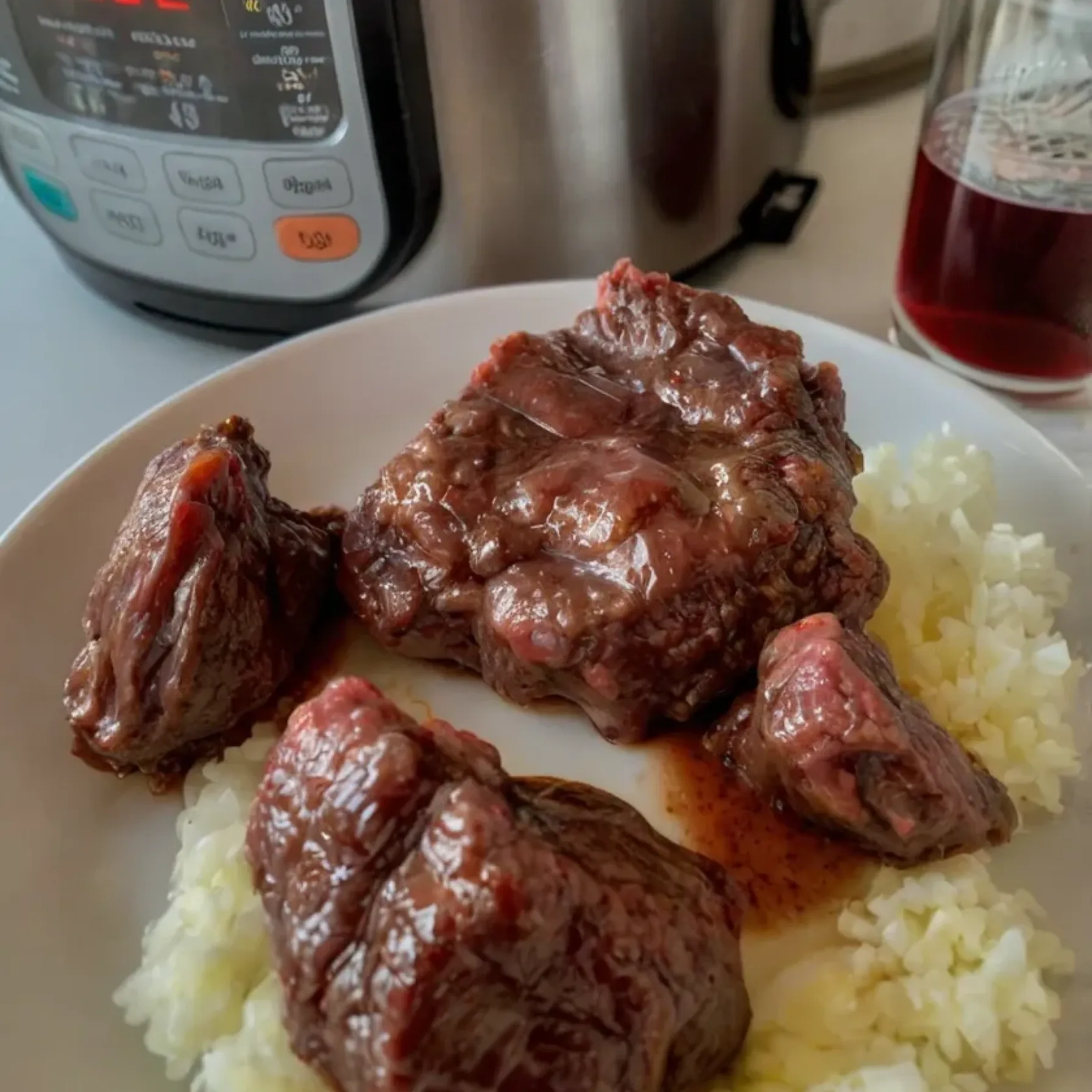How to Cook Perfect Beef Cheeks: 5 Reasons to Try This Beef Cheeks Recipe
Discover a tender and flavorful beef cheeks recipe with easy-to-follow instructions for a delicious meal.
Introduction: The Allure of the Beef Cheeks Recipe
When you think about delicious cuts of beef, your mind might wander to steaks or roasts. But what if we told you that there’s another cut that can elevate your cooking game to a whole new level? This Beef cheeks Recipe might just be the best-kept secret in the world of meat. Known for their rich flavor, tender texture, and versatility, beef cheeks are perfect for any home chef looking to create an unforgettable meal.
Imagine this: a slow-cooked beef cheek, its outer layer caramelized and its interior tender and melt-in-your-mouth. The aroma fills your kitchen, making your stomach rumble with anticipation. Whether it’s a special dinner with loved ones or a cozy meal to unwind after a long day, beef cheeks bring comfort and satisfaction in every bite.
In this article, we’ll walk you through everything you need to know about cooking the perfect beef cheeks. From understanding this cut of meat to preparing a mouthwatering recipe, we’ll cover it all. Ready to impress your guests and satisfy your taste buds? Let’s dive in!
content overview
Table of Contents
What Are Beef Cheeks?
Understanding the Cut: Beef Cheeks Explained
Beef cheeks come from the facial muscles of the cow. These muscles work hard, which means the meat is lean but also full of flavor. Because of the muscle’s natural toughness, beef cheeks require slow cooking to break down their fibers, which transforms them into a tender, juicy cut that can absorb any seasoning or liquid you cook it with.

This cut may not be as well-known as rib-eye or sirloin, but once you try beef cheeks, you’ll understand why it’s gaining popularity among food lovers and chefs alike. They are naturally flavorful and, when cooked properly, offer a melt-in-your-mouth experience unlike any other.
Nutritional Benefits
Beef cheeks are not just about great taste—they’re also packed with nutritional benefits. Rich in protein, iron, and essential vitamins like B12, they provide an energy boost and are an excellent choice for a wholesome, hearty meal. The collagen content in beef cheeks also offers skin and joint benefits, making it a healthful addition to your diet.
Discover more Beef Cheeks Recipe
Beef Cheeks Recipe: A Step-by-Step Guide
Ingredients for the Perfect Beef Cheeks Recipe
Before you start cooking, gather the following ingredients to create a rich, flavorful dish that will leave you coming back for more:
| Ingredient | Amount |
|---|---|
| Beef cheeks | 2 lbs |
| Olive oil | 2 tbsp |
| Onion (diced) | 1 medium |
| Carrot (sliced) | 1 large |
| Celery (chopped) | 2 stalks |
| Garlic (minced) | 4 cloves |
| Red wine | 1 cup |
| Beef broth | 2 cups |
| Tomato paste | 2 tbsp |
| Fresh thyme | 2 sprigs |
| Bay leaves | 2 |
| Salt and pepper | To taste |
Step-by-Step Cooking Instructions
Now that you have your ingredients, let’s break down the cooking process:
1. Prepare the Beef Cheeks
Start by trimming off any excess fat from the beef cheeks. This will help ensure that your dish isn’t too greasy. Season them generously with salt and pepper, ensuring the seasoning is evenly distributed.
2. Sear the Beef Cheeks
Heat the olive oil in a large, heavy-bottomed pot over medium-high heat. Once the oil is hot, add the beef cheeks to the pot. Sear them on all sides until they are nicely browned. This step adds depth to the flavor and will create that beautiful caramelized exterior.
3. Create the Flavor Base
Remove the beef cheeks from the pot and set them aside. In the same pot, add the diced onion, sliced carrot, chopped celery, and minced garlic. Sauté for about 5-7 minutes until the vegetables become soft and aromatic. This will form the flavor base for your dish.
4. Deglaze the Pot
Once the vegetables are softened, it’s time to deglaze the pot. Pour in the red wine and use a wooden spoon to scrape up any browned bits stuck to the bottom of the pot. These bits are packed with flavor and will enhance the taste of your dish. Let the wine simmer for 2-3 minutes to reduce slightly.
5. Add the Liquids and Herbs
Now it’s time to add the beef broth, tomato paste, fresh thyme, and bay leaves to the pot. Stir well to combine. These ingredients will create a savory, rich sauce that will infuse the beef cheeks with incredible flavor.
6. Braise the Beef Cheeks
Return the beef cheeks to the pot, ensuring they are submerged in the liquid. Cover the pot with a tight-fitting lid and reduce the heat to low. Allow the beef cheeks to braise for 3-4 hours, or until the meat is fork-tender and easily shreds.
7. Final Touches
Once the beef cheeks are tender, remove them from the pot and set them aside. If desired, you can shred the beef cheeks with a fork for a more rustic, pulled-meat feel. Serve the beef cheeks with the sauce spooned over the top, or serve the sauce on the side.
Tips for Perfecting Your Beef Cheeks Recipe
Low and Slow: The Key to Tenderness
The secret to perfect beef cheeks is cooking them low and slow. This slow cooking process allows the tough fibers in the meat to break down and become tender. Patience is key here—rushing the cooking process will result in tough meat. Keep the heat low, and give the meat plenty of time to cook.

Discover more Beef Cheeks Recipe
Marinate for Extra Flavor
If you want to take your beef cheeks to the next level, consider marinating them before cooking. Marinating the beef cheeks in a mixture of red wine, herbs, and garlic for 4-6 hours (or even overnight) can enhance the flavor even further. The marinade will help tenderize the meat and infuse it with more depth and richness.
Don’t Forget to Skim the Fat
As your beef cheeks braise, you may notice some fat rising to the surface of the liquid. Don’t be afraid to skim this off occasionally to prevent your dish from becoming too greasy. This will help keep the flavors balanced and the dish light.
Pairing Your Beef Cheeks Dish
Beef cheeks are rich and savory, so pairing them with a lighter side can create a balanced meal. Here are a few options to consider:
- Mashed Potatoes: The creamy, buttery texture of mashed potatoes complements the rich beef cheeks perfectly.
- Roasted Vegetables: Carrots, parsnips, or Brussels sprouts roasted with olive oil and herbs add a nice contrast to the dish.
- Crusty Bread: A slice of fresh bread is perfect for soaking up the flavorful sauce.
Wine Pairing
Since beef cheeks are a hearty dish, pair them with a bold red wine like Cabernet Sauvignon, Merlot, or Malbec. The acidity and tannins in the wine will balance the richness of the meat.
Beef Cheeks: The Ideal Meal for Special Occasions
Why Beef Cheeks Are Perfect for Special Events
If you’re looking to impress at your next dinner party or holiday gathering, beef cheeks should be at the top of your list. They are luxurious yet affordable, making them an excellent choice for any special occasion. Not only will they fill your kitchen with a delightful aroma, but they’ll also wow your guests with their unique flavor and tenderness.
How to Serve Beef Cheeks for Special Occasions
Beef cheeks can be served in several ways, depending on the occasion. For a more casual, family-style meal, serve the beef cheeks on a large platter, allowing everyone to help themselves. For a more formal gathering, plate the beef cheeks individually with sides, garnishing them with fresh herbs or a drizzle of sauce.
Beef Cheeks Around the World: Global Variations
How Different Cultures Prepare Beef Cheeks
Beef cheeks are enjoyed in various cuisines around the world, each adding a unique twist to this cut of meat:
- Mexican-Style Barbacoa:
In Mexico, beef cheeks are slow-cooked with spices like cumin, garlic, and chili. This traditional preparation creates a flavorful, tender dish that’s perfect for tacos or served with rice and beans. - French Boeuf Bourguignon:
In France, beef cheeks are braised in red wine with mushrooms, carrots, and onions. The result is a classic French dish known for its depth of flavor and rich sauce. - Asian-Inspired Beef Cheeks:
In some Asian cultures, beef cheeks are cooked with soy sauce, ginger, garlic, and star anise, creating a sweet and savory dish that pairs wonderfully with rice or noodles.
Discover more Beef Cheeks Recipe
Frequently Asked Questions (FAQs)
Common Queries About Beef Cheeks Recipe
Q1: Can I cook beef cheeks in a slow cooker?
Absolutely! Beef cheeks are ideal for slow cooking. Simply follow the same preparation steps, but instead of braising on the stovetop, cook them on low in a slow cooker for 6-8 hours. This method allows the meat to become even more tender.
Q2: How do I know when the beef cheeks are done?
The beef cheeks are done when they are fork-tender and easily shred. If the meat pulls apart with little effort, it’s ready to serve.
Q3: Can I substitute beef cheeks with another cut of meat?
While beef cheeks offer a unique texture and flavor, you can substitute them with other cuts like chuck roast or short ribs. However, keep in mind that the texture and cooking time may differ.
Q4: What are some variations of the beef cheeks recipe?
You can experiment with different cooking liquids, like stout beer, or add spices like smoked paprika for a smoky, tangy twist. The possibilities are endless, so feel free to get creative!
Conclusion: Why Beef Cheeks Should Be Your Next Culinary Adventure
Beef cheeks offer an unforgettable meal experience—tender, flavorful, and full of depth. Whether you’re cooking for a special occasion or simply treating yourself to something new, this cut of meat is a must-try. So roll up your sleeves, grab your ingredients, and get cooking. You won’t regret it.
Let Us Know What You Think of This Recipe
There are no reviews yet. Be the first one to write one.

